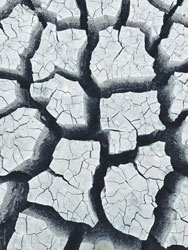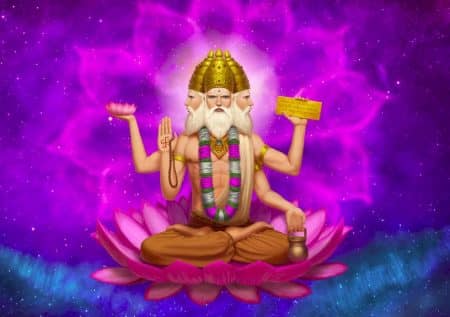
Sanatanies
Prakritic (pre-classical-cosmic creation) Timeless Holistic Philosophy
Climate change – from the beginning to the present day.
Photo: Brahma (creator of Brahmand -the universe)
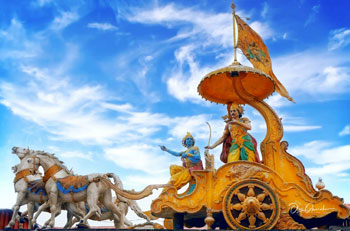
"The environment is not ours to take or leave, it is ours to make"
Over five thousand years ago, Sri Krisha explained to Arjun (Gita 9:10) about the profound climate change we are now experiencing. Our cultural attitude of exploiting natural resources without restraint has disrupted delicate ecological systems, leading to alarming and urgent climate challenges.
However, turning our backs on the environment is not a viable option. The condition of our ecological home, whether we choose to acknowledge it or not, will inevitably affect us and our descendants. If we persist in harming our ecological home, we will undeniably face the repercussions. Throughout the centuries, the prevailing cultural mindset allowed us to exploit natural resources without restraint, disrupting fragile ecological systems and unleashing devastating consequences. The unmistakable evidence of our audacious treatment of nature is manifesting as menacing climate challenges.
Unfortunately, some people have reacted strongly to the growing environmental concern, dismissing much of the current environmental conversation as alarmist. They argue that we should leave the environment alone, and it will take care of itself. The time to act is now.
The Seven Perceptual Climate Elements – Five (Panch Bhut) Plus Two
Bhumi (earth), Jal (water), Agni (fire), Vayu (air), Akash (space), and Chandra (moon) & Surya (sun)
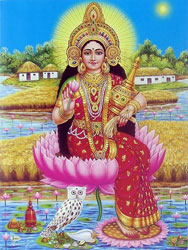
Mata Bhumi (Mother Earth)
Mata Bhumi (Mother Earth), we are immensely grateful for providing us with land and water essential for our survival.
Plants And Environment
We deeply regret causing harm by digging for food. We earnestly implore you to regrow it soon.
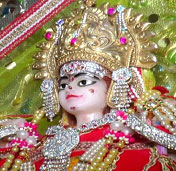
Jal Devi (incarnation of River Ganges)
Jal Devi, also known as Varunani or Jaldevi, is the consort of Varuna, the Water god. She is intimately connected with water bodies such as oceans, rivers, clouds, rain, and other vital elements of nature.
Photo: Ma Jaldevi at mandir situated in Sansera, Rajasthan, India
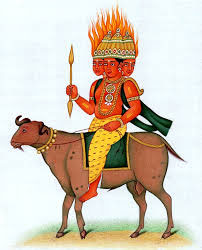
Agni Dev (Fire God)
Agni Dev holds special significance and is one of the most invoked deities. He is considered the mouth of the gods and goddesses and is the medium through which offerings are conveyed to them during a homa ritual. Agni is believed to exist at three levels: on earth as fire, in the atmosphere as lightning, and in the sky as the sun. This triple presence signifies his role as the messenger between the deities and humans.
Photo: Agni Dev sits upon his mount, a sheep, with flames leaping upwards from his crown.
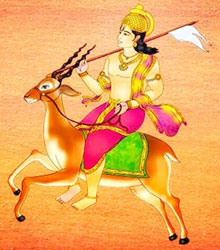
Vayu Dev (wind god)
Vayu Dev, also known as Pavan (the wind god), is considered the life breath of the world and the guardian of directions. The word “vāyu,” commonly used to refer to physical air or wind, is also used interchangeably with “prāna,” meaning life. Additionally, “Vāta,” another name for the deity Vayu, is the root of “vātāvaranam,” the Sanskrit term for “atmosphere.”
Photo: Vayu Dev, wearing a crown, has four arms and rides an antelope
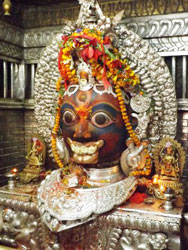
Dyaus/Akash (sky father)
Dyaus/Akash, His consort is Prithvi, the earth goddess, and together they act as the archetypal parents. Dyaús refers to the daylight sky. Under different theonyms, Dyavaprithvi, for example, is a dvandva compound combining ‘heaven’ and ‘earth’ as Dyauṣ and Prithvi. Dyauṣ is also stated to be like a black stallion studded with pearls in a simile with the night sky.
Photo: The head of the Aakash Bhairav was dug up several hundred years ago in Kathmandu
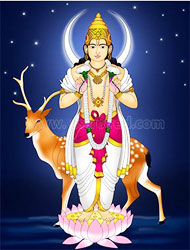
Chandra (moon)
Chandra, whose name signifies brightness, radiance, or glittering, is a revered lunar deity known by various other names, such as Soma, which symbolizes the vital essence of plants and forests. Soma is also the etymological root of Somavaar, denoting Monday. Chandra’s significance is a subject of controversy and scholarly debate, especially within the context of its status as one of the nine celestial bodies classified as planets.
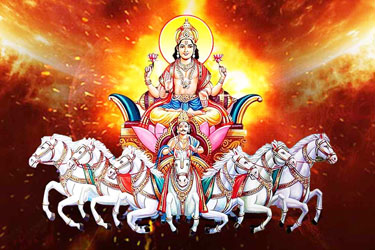
Surya Dev (Sun God)
Surya Devta (solar deity) has many names, such as Aditya, Arka, Bhanu, Savitr, Pushan, Ravi, Martanda, Mitra, Bhaskara, Prabhakara, Kathiravan, and Vivasvan. Surya is often depicted riding a chariot harnessed by seven horses, which represent the seven colours of visible light, and the seven days of the week. Surya is the lord of Simha (Leo), one of the twelve constellations in the zodiac system. Surya survived as a primary longer than any most of the original deities.
Atma Manthan – Soul Search
Your contribution to climate change!

